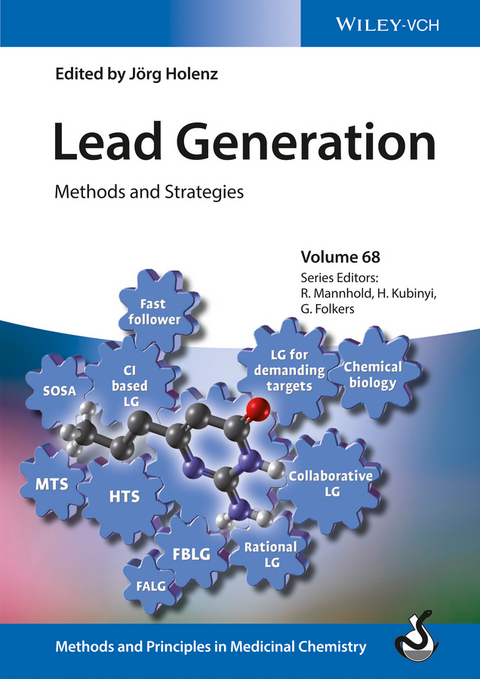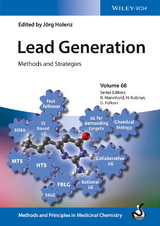Lead Generation
Wiley-VCH (Verlag)
978-3-527-33329-5 (ISBN)
Joerg Holenz is a trained organic and medicinal chemist and acquired his PhD in Germany on the synthesis of alkaloids as antimalarial agents. After leading the preclinical activities of the marketed analgesic Tapentadol (Grünenthal Pharmaceuticals GmbH), he headed the medicinal chemistry department of Barcelona-based Laboratorios Esteve. He then moved to AstraZeneca's CNS/ pain research unit in Sweden to head lead generation chemistry. In 2012, Joerg was selected to join AZ's newly formed 'virtual' neuroscience unit in Boston as director of discovery and preclinical sciences. As a project leader he is responsible for pioneering a novel concept of driving research and development projects via increased use of academic and industry collaborative networks. In his career, Joerg worked predominantly with peripheral and central targets in the pain and neuroscience disease areas. He has edited, authored or contributed to more than 45 publications, 50 patent applications and several books and book chapters.
VOLUME 1
PART I: INTRODUCTION
#01 Introduction - Learnings from the Past - Characteristics of Successful Leads
#02 Modern Lead Generation Strategies
PART II: THE IMPORTANCE OF TARGET IDENTIFICATION FOR GENERATING SUCCESSFUL LEADS
#03 `Ligandability' of drug targets: assessment of chemical tractability via experimental and in silico approaches
#04 Chemistry-Driven Target Identification
PART III: HIT GENERATION METHODS
#05 Lead Generation based on Compound Collection Screening
#06 Fragment-based Lead Generation
#07 Rational Hit Generation
#08 Competitive Intelligence-based Lead Generation and Fast Follower Approaches
#09 Selective Optimization of Side Activities (SOSA): An Alternative and Promising Strategy for Lead Generation
#10 Lead Generation for Challenging Targets
#11 Collaborative Approaches to Lead Generation
VOLUME 2
PART IV: CONVERTING HITS TO SUCCESSFUL LEADS
#12 A Medicinal Chemistry Perspective on the Hit-to-Lead Phase in the Current Era of Drug Discovery
#13 Molecular Recognition and its Importance for Fragment-Based-Lead-Generation and Hit-to-Lead
#14 Affinity-based Screening Methodologies and their Application in the Hit to Lead Phase
#15 Predictive Methods in Lead Generation
#16 Lead Quality
PART V: HYPOTHESIS-DRIVEN LEAD OPTIMIZATION
#17 The Strategies and Politics of Successful Design, Make, Test, Analyze (DMTA) Cycles in Lead Generation
PART VI: RECENT LEAD GENERATION SUCCESS STORIES
#18 Lead Generation paved the way for the discovery of a novel H3 Inverse Agonist Clinical Candidate
#19 Vorapaxar - From Lead Identification to FDA Approval
#20 Lead generation approaches delivering inhaled ß2-adrenoreceptor agonist drug candidates.
#21 GPR81 Case Study
#22 Development of Influenza Virus Sialidase Inhibitors
#23 The Discovery of Cathepsin A inhibitors. A project adapted fragment approach based on HTS results
#24 Lead Structure Discovery for Neglected Diseases - Product Development Partnerships driving Drug Discovery
#25 A Fragmentation-Enumeration Approach to Generating Novel Drug Leads
| Erscheint lt. Verlag | 4.5.2016 |
|---|---|
| Reihe/Serie | Methods and Principles in Medicinal Chemistry |
| Mitarbeit |
Herausgeber (Serie): Raimund Mannhold, Hugo Kubinyi, Gerd Folkers |
| Verlagsort | Weinheim |
| Sprache | englisch |
| Maße | 170 x 240 mm |
| Gewicht | 2058 g |
| Themenwelt | Medizin / Pharmazie ► Medizinische Fachgebiete ► Pharmakologie / Pharmakotherapie |
| Medizin / Pharmazie ► Pharmazie | |
| Naturwissenschaften ► Chemie | |
| Technik | |
| Schlagworte | Biowissenschaften • Chemical Informatics • Chemie • Cheminformatik • Chemistry • Chemoinformatik • Drug Discovery & Development • Drug Discovery & Development • Life Sciences • Molecular Biology • Molekularbiologie • Pharmazeutische Chemie • Wirkstoffe • Wirkstoffforschung • Wirkstoffforschung u. -entwicklung |
| ISBN-10 | 3-527-33329-0 / 3527333290 |
| ISBN-13 | 978-3-527-33329-5 / 9783527333295 |
| Zustand | Neuware |
| Informationen gemäß Produktsicherheitsverordnung (GPSR) | |
| Haben Sie eine Frage zum Produkt? |
aus dem Bereich




